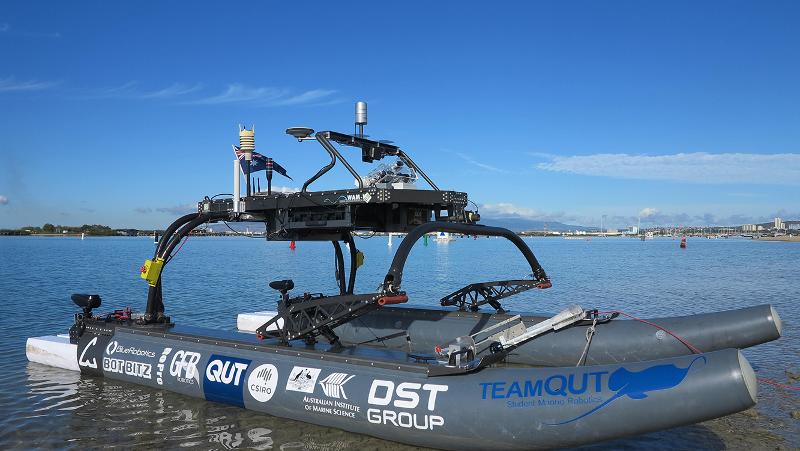
The future of maritime emergency response could look a lot like Bruce.
Built by a team of seven QUT students, Bruce is a robo-boat: autonomous, versatile – and representing Australia at the second-ever Maritime RobotX Challenge in Hawaii this week.
To beat the other 12 university teams from five countries, using the same basic hull, Bruce will need to complete a range of autonomous tasks that have real-world applications for emergency response and environmental management.
TeamQUT captain and PhD student Leo Stanislas said the competition was designed to inspire advances in the field of marine robotics.
“Search and rescue professionals are often prevented from doing their job by the rough ocean conditions but an autonomous boat can work any time and in any weather,” Mr Stanislas said.
“Some of our competition tasks involve avoiding obstacles while locating particular objects and locating acoustic pingers underwater, which have obvious relevance for search and research scenarios.
“One of the tasks Bruce has to perform is to locate a floating target and shoot balls into it – it sounds like a kids’ game but the technologies we’ve all developed to solve this problem could allow autonomous boats in the future to fight fires without human help.
“Likewise, from an environmental perspective, the technologies each team has developed to locate shapes on the seafloor could, for instance, be adapted to help autonomous boats map the extent of coral bleaching events.”
TeamQUT is the underdog despite claiming third place in 2014. On a shoestring budget themselves, the young roboticists are up against some well-known, highly experienced university teams including Georgia Tech and Seoul National University.
Bruce has some extra robotic support to put him in good stead, built from scratch by TeamQUT – a submarine called George which will be Bruce’s eyes and ears underwater, and Gusto the racquetball launcher.
QUT roboticist and team supervisor Dr Matthew Dunbabin said regardless of their final place, the competition puts his students at the forefront of a new industry.
“This is a great opportunity for Australia to showcase not just its hardware but also the huge wealth of talent in our future roboticists,” Dr Dunbabin said.
“RobotX is also a fantastic technical and networking experience for these students, an opportunity to gain exposure to a world-class industry and to meet some of its key players. The world leaders in robotics are watching this competition closely.”
The Maritime RobotX competition runs December 11-18 in Oahu, Hawaii.
TeamQUT members will be contactable periodically by email during that time. Contact QUT Media for interview requests.
Meet the team:
Leo Stanislas (West End 4101), team captain: “This project gives me hands-on experience with an advanced robotics system and all the challenges entailed, as well as a chance to implement state-of-the-art techniques in robotics to perform complex tasks that have never been done before. My team leader position allows me to develop my project management skills by linking the different project modules and supporting all team members in delivering their part of the project in time.”
Peter Kujala (Upper Mt Gravatt 4122), Gusto’s creator: “Participation in these sorts of competitions is a great way to get your hands dirty with tackling the challenges of implementing robotics and autonomous systems it the “wild”. Once you put a system of systems together and take it out of controlled conditions (i.e. into the unpredictable domain of the natural world - especially the marine environment) a host of unpredictable issues can arise and need to be overcome on the fly - a kind of ‘sink or swim’ paradigm. Nothing can substitute for the hands-on nature of participating in a large robotics challenge, be it a competition like the Maritime RobotX or solving other real problems in industry using robotics.”
Brendan Tidd (Griffin 4503), George’s creator: “By participating in this competition, I have gained valuable real-world experience in field robotics and an appreciation for maritime vessels, particularly underwater vehicles, and an understanding of the potential for underwater robots in the future.”
Will Chamberlain (Samford 4520), task scheduler: “I liken Team QUT to the Formula 1 drivers battling it out in the middle of the pack. We’re not the well-funded favourites who tend to lead the race but we stand a great chance against the bulk of the other teams.”
Peter Smith (Eastern Heights 4305), simulations expert.
Akira Dawson (West End 4101), multimedia maker.
Scott Nicholson (Highvale 4520), computer vision specialist.
Dr Markus Eich (New Farm 4005), mission control and software support.
Dr Matthew Dunbabin (Manly 4179) support and mentoring.
Media contacts
Kate Haggman, QUT Media, 07 3138 0358, kate.haggman@qut.edu.au
After hours Rose Trapnell, QUT Media team leader, 0407 585 901, media@qut.edu.au
QUT is part of a national collaborative group of five major Australian universities that form the ATN (Australian Technology Network of Universities).




